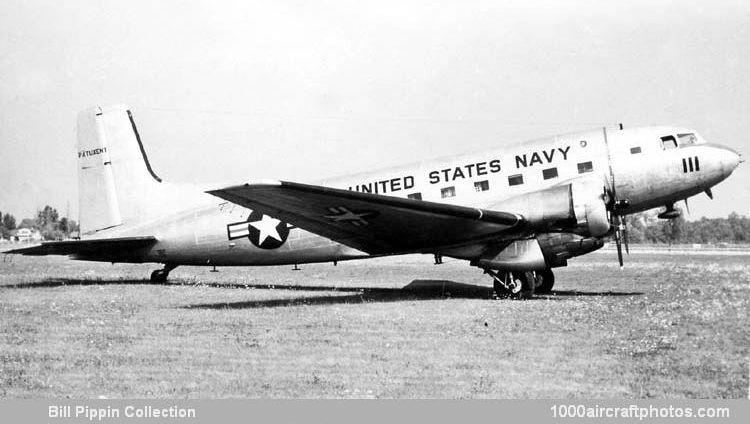12/29/2014. Remarks by Johan Visschedijk: "No sooner had production of the DC-3 ended than a search for its successor began. Understandably, Douglas had a vital interest in finding the replacement, and some preliminary work was done during 1947. Later, the threat of impending Civil Air Regulations (CAR), too stringent to allow renewed CofAs for the standard DC-3s and converted C-47s, lent a new urgency to the project.
To save engineering time and cost and to reduce price while providing new life for the large number of DC-3s and derivatives looming expiry of their CofAs in 1952, Douglas decided to concentrate its efforts on modernizing existing aircraft rather than designing an entirely new machine. After initial design work had been done by a team comprising many of the DC-3's original designers, the project was transferred to a special group led by M.K. Oleson. To meet the new CAR, the aircraft's stability, single-engined performance and take off had to be improved, and competitive pressures made it necessary to improve its speed.
Using two used aircraft, an ex C-47-DL, USAAF s/n 41-18656 c/n 6017, and an ex DC-3, NC15579 c/n 4122, Douglas undertook to build two prototypes of the DC-3S better known as the Super DC-3. The fuselage structure was strengthened, a 3 ft 3 in (99 cm) section with an extra window on each side was added to the fuselage forward of the front wing spar, thus increasing normal seating capacity to thirty, and the passenger door, now also acting as an integral airstair, was moved forward. New vertical and horizontal tail surfaces with squared tips and increased area were fitted and the dorsal fin area was substantially increased to improve single-engined handling.
The wing center section was left unchanged but new outer panels with squared tips and 15.5º sweep on the leading edge and 4º sweep on the trailing edge replaced the original wing outboard sections. Span was reduced from the 95 ft (28.96 m) of the standard DC-3 to 90 ft (27.43 m) and wing area was cut from its 986 sq.ft (91.696 sq.m) to 969 sq.ft (90.023 sq.m). New, smoother, engine nacelles with doors fully enclosing the strengthened landing gear were designed to accommodate either 1,475 hp Wright Cyclone R-1820-C9HE nine-cylinder radials or 1,450 hp Pratt & Whitney R-2000-D7 fourteen-cylinder radials driving fully-feathering propellers.
After completion of the extensive modernization program, c/n 6017 emerged as the first DC-3S and was given new registration and construction numbers: N30000 c/n 43158. Powered by two Wright R-1820-C9HE engines, the aircraft made its first flight at Clover Field, Santa Monica, California, on June 23, 1949, with John F. Martin at the controls. Flight test results exceeded expectations and there was little doubt that the Super DC-3 would meet all CAR requirements while offering increased payload and improved performance. Compared with the DC-3C, maximum speed increased from 230 mph (368 kmh) to 270 mph (432 kmh), cruising speed from 207 mph (331 kmh) to 251 mph (401 kmh), and initial rate of climb from 1,130 ft (345 m)/min to 1,300 ft (396 m)/min. Following completion of the flight trial program the aircraft was used by Douglas for a sales tour of the USA. Meanwhile, the second DC-3S, ex c/n 4122, was completed, and renumbered N15579 c/n 43159 it was flown with Pratt & Whitney R-2000-D7 engines.
In spite of offering markedly improved performance, the commercial Super DC-3 program proved a failure and, as a result of the sales tour, only Capital Airlines' interest in the aircraft was converted into an order for three R-1820-C9HE powered machines, while the second prototype was acquired by a construction company. Major airlines preferred the more modern and faster Convair-Liner series with pressurized cabins. Smaller airlines, including the US local service airlines which had been the prime sales targets, found the Super DC-3 too expensive for their tight budgets and in any case were finally able to retain current CofAs on their large holdings of standard DC-3s.
Having failed to sell the Super DC-3 to the airlines, Douglas sold the first prototype of the aircraft to the USAF which assigned to it the serial 51-3817 and the designation YC-129, this being later changed to YC-47F. Following trials, the USAF decided not to adopt the YC-47F and the aircraft was transferred to the USN as the R4D-8X (BuNo. 13820).
At last Douglas had found a customer for the Super DC-3, the US Navy awarding the manufacturers a contract to modify one hundred R4D-5s, R4D-6s and R4D-7s to R4D-8 configuration. Powered by two 1,475 hp Wright R-1820-80s, the modernized aircraft were assigned a new factory c/n (43301 to 43400) but retained their original BuNo. Some of the aircraft in this batch were modified to fulfill a variety of missions and were especially redesignated as follows: R4D-8T (TC-117D after 1962) trainers, R4D-8Z (VC-117D) staff transports and R4D-8L (LC-117D) transports modified for cold-weather operation. All standard R4D-8s became C-117Ds in 1962 and the type was still in service with naval squadrons during the early seventies.
The pictured aircraft was built as a DC-3A-456 C-47A-1-DK Skytrain under the USAAF s/n 42-108813 c/n 11978. On October 16, 1943 it was transferred to the USN as a R4D-5 under the BuNo. 17111. Eventually it was converted to a R4D-8 with new c/n 43304."
